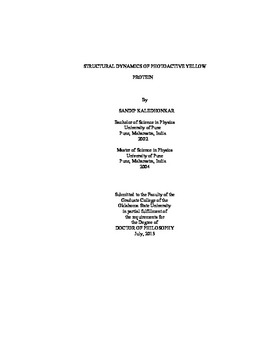| dc.contributor.advisor | Xie, Aihua | |
| dc.contributor.author | Kaledhonkar, Sandip | |
| dc.date.accessioned | 2014-09-24T14:17:00Z | |
| dc.date.available | 2014-09-24T14:17:00Z | |
| dc.date.issued | 2013-07 | |
| dc.identifier.uri | https://hdl.handle.net/11244/11025 | |
| dc.description.abstract | Photoactive yellow protein (PYP) is a blue light photoreceptor protein. PYP is a structural prototype of the PAS domain superfamily of regulating and signaling proteins. Upon absorption of a blue light photon, PYP exhibits a photocycle leading to the signaling state. We study structure-function relation in the PYP family by investigating single point mutants of Halorhodospira halophila (Hhal) PYP and homologous PYPs from three different bacteria. We study the role of Asn43 in Hhal PYP, a one of the nine well conserved residues in the PAS domain superfamily. The time-resolved FTIR difference spectroscopy of Asn43Ala PYP shows that this residue plays a key role in regulating kinetics of signaling of PAS domain. The FTIR absorption spectrum of Idiomarina loihiensis (Il) and Hhal PYP shows that the secondary structures of the Il PYP are similar to that of Hhal PYP. The decay of long lived putative signaling pB state of Il and Hhal PYP follows similar kinetics, yet these PYP perform different biological functions. We have observed a novel spectral isotopic effect (SIE) in Salinibacter ruber (Sr) and Hhal PYP through UV/Vis absorption spectroscopy. SIE offers possibility to examine hydrogen bonding strength in proteins. | |
| dc.description.abstract | Despite extensive studies since 1887 ( Arc. Exp. Pathol. Pharmacol. 1887, 29: 1-16), it remains unclear how salt solutions alter stability and solubility of protein. We employ PYP as a model system to study impact of salts on structural dynamics of protein. The time-resolved step-scan Fourier transform infrared spectroscopy (FTIR) with 5 mus time resolution and time-resolved rapid-scan FTIR with 8 ms time resolution were employed in this study to capture the dynamic structural development of PYP upon light stimulation. We found that salts do not alter photoisomerization of p-coumaric acid (pCA) and proton transfer pathway from Glu46 to pCA upon photoexciation of PYP. Thus salt do not affect structural changes inside protein. Our study reveals that, salt suppresses conformational changes of PYP strongly, thus formation of signaling state of PYP for bacterial phototaxis is inhibited in high salt solutions. The suppression of conformational changes of PYP signaling state in high salt solution is attributed to effective dehydration of proteins. The knowledge gained may be applied to understand the effect of high salt concentration on stability and solubility of the proteins, which is known as Hofmeister effect. | |
| dc.format | application/pdf | |
| dc.language | en_US | |
| dc.rights | Copyright is held by the author who has granted the Oklahoma State University Library the non-exclusive right to share this material in its institutional repository. Contact Digital Library Services at lib-dls@okstate.edu or 405-744-9161 for the permission policy on the use, reproduction or distribution of this material. | |
| dc.title | Structural dynamics of photoactive yellow protein | |
| dc.contributor.committeeMember | Hauenstein, Robert J. | |
| dc.contributor.committeeMember | Zhou, Donghua H. | |
| dc.contributor.committeeMember | Hoff, Wouter D. | |
| osu.filename | Kaledhonkar_okstate_0664D_12904.pdf | |
| osu.accesstype | Open Access | |
| dc.type.genre | Dissertation | |
| dc.type.material | Text | |
| thesis.degree.discipline | Physics | |
| thesis.degree.grantor | Oklahoma State University | |
